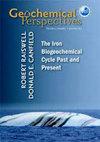Anoxia-Related Biogeochemistry of North Indian Ocean
IF 2.5
3区 地球科学
Q1 GEOCHEMISTRY & GEOPHYSICS
引用次数: 1
Abstract
Complex interactions between microbial communities and geochemical processes drive the major element cycles and control the function of marine sediments as a dynamic reservoir of organic matter. Sulfate reduction is globally the dominant pathway of anaerobic mineralisation and is the main source of sulfide. The effective re-oxidation of this sulfide at the direct or indirect expense of oxygen is a prerequisite for aerobic life on our planet. Although largely hidden beneath the oxic sediment surface, the sulfur cycle is therefore critical for Earth’s redox state. This Geochemical Perspectives begins with a brief primer on the sulfur cycle of marine sediments and a description of my own scientific journey through nearly fifty years of studies of sulfur geochemistry and microbiology. Among the main objectives of these studies were to quantify the main processes of the sulfur cycle and to identify the microbial communities behind them. Radiotracers in combination with chemical analyses have thereby been used extensively for laboratory experiments, supported by diverse molecular microbiological methods. The following sections discuss the main processes of sulfate reduction, sulfide oxidation and disproportionation of the inorganic sulfur intermediates, especially of elemental sulfur and thiosulfate. The experimental approaches used enable the analysis of how environmental factors such as substrate concentration or temperature affect process rates and how concurrent processes of sulfate reduction and sulfide oxidation drive a cryptic sulfur cycle. The chemical energy of sulfide is used by chemolithotrophic bacteria, including fascinating communities of big sulfur bacteria and cable bacteria, and supports their dark CO2 fixation, which produces new microbial biomass. During the burial and aging of marine sediments, the predominant mineralisation processes change through a cascade of redox reactions, and the rate of organic matter degradation drops continuously over many orders of magnitude. The main pathways of anaerobic mineralisation and the age control of the organic matter turnover are discussed. In the deep methanic zone, only a few percent of the entire degradation process remains, which provides a small boost of substrate for sulfate reduction through the process of anaerobic methane oxidation. The stable isotopes of sulfur provide an additional tool to understand these diagenetic processes, whereby the combination of microbial isotope fractionation and open system diagenesis generate a differential diffusion flux of the isotopes. In relation to the organic carbon cycle of the seabed and the contribution of methane, the paper discusses the global sulfur budget and the role of sulfate reduction for organic matter mineralisation in different depth regions of the ocean - from coast to deep sea. The published estimates of these parameters are evaluated and compared. Finally, the paper looks at future perspectives with respect to gaps in our current understanding and the need for further studies.北印度洋缺氧相关生物地球化学
微生物群落与地球化学过程之间的复杂相互作用驱动了主要元素循环,并控制着海洋沉积物作为有机物质动态储层的功能。硫酸盐还原是全球厌氧矿化的主要途径,也是硫化物的主要来源。在直接或间接消耗氧气的情况下,这种硫化物的有效再氧化是我们星球上有氧生命的先决条件。虽然大部分隐藏在含氧沉积物表面之下,但硫循环对地球的氧化还原状态至关重要。这本地球化学展望书首先简要介绍了海洋沉积物的硫循环,并描述了我自己近五十年来对硫地球化学和微生物学的研究。这些研究的主要目标之一是量化硫循环的主要过程,并确定其背后的微生物群落。因此,放射性示踪剂与化学分析相结合已广泛用于实验室实验,并得到各种分子微生物学方法的支持。下面几节讨论了无机硫中间体,特别是单质硫和硫代硫酸盐的硫酸盐还原、硫化物氧化和歧化的主要过程。所使用的实验方法能够分析环境因素(如底物浓度或温度)如何影响过程速率,以及硫酸盐还原和硫化物氧化的同时过程如何驱动隐硫循环。硫化物的化学能被化能岩石营养细菌所利用,包括迷人的大型硫细菌和电缆细菌群落,并支持它们的暗CO2固定,从而产生新的微生物生物量。在海洋沉积物的埋藏和老化过程中,主要的矿化过程通过一系列氧化还原反应发生变化,有机物降解的速度连续下降了许多数量级。讨论了厌氧矿化的主要途径和有机质周转的年龄控制。在深层甲烷区,整个降解过程只剩下百分之几,这为通过厌氧甲烷氧化过程还原硫酸盐提供了一个小的底物。硫的稳定同位素为了解这些成岩过程提供了一个额外的工具,微生物同位素分馏和开放体系成岩作用的结合产生了同位素的微分扩散通量。关于海底有机碳循环和甲烷的贡献,本文讨论了全球硫收支和硫酸盐还原对海洋不同深度区域(从海岸到深海)有机质矿化的作用。对已公布的这些参数估计值进行评估和比较。最后,本文着眼于未来的观点,考虑到我们目前的理解差距和进一步研究的需要。
本文章由计算机程序翻译,如有差异,请以英文原文为准。
求助全文
约1分钟内获得全文
求助全文
来源期刊

Geochemical Perspectives
GEOCHEMISTRY & GEOPHYSICS-
CiteScore
0.80
自引率
0.00%
发文量
1
期刊介绍:
Each issue of Geochemical Perspectives presents a single article with an in-depth view on the past, present and future of a field of geochemistry, seen through the eyes of a highly respected member of our community. The articles combine science and history of the field’s development and the scientist’s opinions about future directions. We expect personal glimpses into the author’s scientific life, how ideas were generated, pitfalls and triumphs along the way, and how ideas were adopted to carry our field further. Perspectives articles are intended for the entire geochemical community, not for experts. They are not reviews or monographs or text books. They go beyond the current state of the art, providing opinions about future directions and impact in the field.
 求助内容:
求助内容: 应助结果提醒方式:
应助结果提醒方式:


